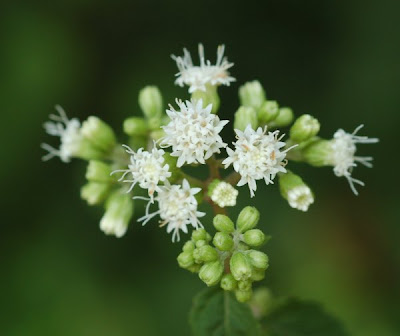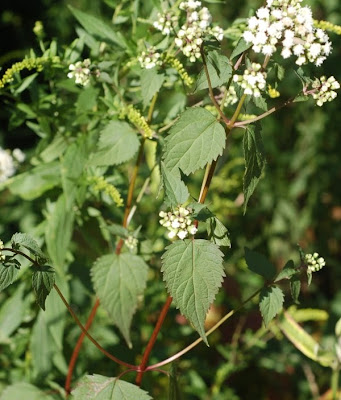
It seems our little field is a cornucopia of toxic plants, both native and introduced. I've long recognized this as "some sort of Eupatorium," but I decided it was time for more precision. Because I don't have the "Compositae" volume of The Flora of West Virginia, I turned to my field guide collection, and soon determined this was White Snakeroot, Eupatorium rugosum, a native plant. When I visited the USDA Plant Database to confirm my identification, I learned that Eupatorium rugosum is a junior synonym of Ageratina altissima (L.). I haven't identified when the revision occurred, but a huge, widely-distributed genus like Eupatorium sensu latu was bound to need some taxonomic attention.
White Snakeroot is the cause of "the milk sick" that killed Nancy Hanks, described here by Lincoln's law partner, William Hernodon:
In the fall of 1818, the scantily settled region in the vicinity of Pigeon Creek [Indiana] ... suffered a visitation of that dread disease common in the West in early days, and known in the vernacular of the frontier as "the milk sick."
It hovered like a spectre over the Pigeon Creek settlement for over ten years, and its fatal visitation and inroads among the Lincolns, Hankses, and Sparrows finally drove that contingent into Illinois.
To this day the medical profession has never agreed upon any definite cause for the malady, nor have they in all their scientific wrangling determined exactly what the disease itself is....A fatal termination may take place in sixty hours, or life may be prolonged for a period of fourteen days.... Sometimes it runs into the chronic form, or it may assume that form from the commencement, and after months or years the patient may finally die or recover only a partial degree of health."
When the western frontier still lay in the Eastern Deciduous Forest, cattle often wandered into the woods to browse on White Snakeweed. It not only poisoned the cows, but was concentrated and passed along in the cows' milk. The settlers were correct in naming milk as the cause, although the "medical establishment" was slow to catch on. White snakeroot... by George Ellison for The Smokey Mountain News describes the "milk sick" history:
Milk Sick Cove ... Milk Sick Holler ... Milk Sick Ridge ... Milk Sick Knob ... and similar place names are common throughout the southern mountains. They are so-called because of an association with a once mysterious and deadly disease known variously as "milk sick" or "milk sickness" or"puke fever" or "the slows" or "the trembles."
....The search for the killer plant is filled with wrong turns, chauvinism, regionalism, and general pigheadedness. In the 19th century scientific research was concentrated in the northeastern United States where milk sickness did not occur; accordingly, the problem was viewed from a theoretical perspective rather than from a practical and preventative one....
In 1838, an Ohio farmer, suspecting that white snakeroot might be the cause, fed leaves from the plant to some of his animals. Sure enough, they developed milk sickness and died. The farmer published his exciting find in the local newspaper. But farmers don't make medical discoveries, do they? No, at that time, only certified professionals were allowed to make discoveries. A famous eastern physician, Dr. Daniel Drake, denounced the farmer's experiments. He was sure that the cause was poison ivy. Dr. Drake, alas, helped set back milk sick research and treatment for nearly a century, causing, indirectly, thousands upon thousands of deaths, predominantly infants.
At about the same time, Anna Pierce Hobbs Bixby came into the Illinois wilderness with her family. Upset by the poor health of her neighbors, she decided to become a physician and returned to Philadelphia to take training in nursing, midwifery, and dental extraction, the only courses women offered to women at that time.
After her return to Illinois, an epidemic tore through the little settlement where she resided and practiced as Doctor Anna. She noted in her diary that the humans and animals contracting the disease had been drinking milk. In an attempt to locate the "guilty" plant, she followed grazing cattle, observing the plants they fed upon. But she was baffled in her field research until she happened upon an elderly Indian medicine woman known as Aunt Shawnee. When Doctor Anna described what she was looking for to Aunt Shawnee, the older woman took her into the woods and pointed to white snakeroot.
Like the Ohio farmer, Doctor Anna tested the plant on a calf, which soon developed "the trembles," while other animals not fed the plant were fine. She started a white snakeroot eradication program that virtually eliminated milk sickness from southeastern Illinois within three years. Wanting other doctors to know about white snakeroot, she grew a patch in her garden and wrote letters inviting physicians to come and examine it for themselves....The eastern medical establishment, alas, ignored the findings of the two women....
Finally, in the 1920s, researchers at the U.S. Department of Agriculture led by Dr. James Couch isolated from white snakeroot a highly complex alcohol they named tremetol. More recent research has refined the original USDA scientific analysis, but the culprit plant had, finally, been officially "discovered." Information was spread in the late 1920s throughout the medical and agricultural communities. Fencing laws and supervised milk production largely solved the milk sick problem....

Some further information about White Snakeroot:
- Missouriplants.com: Photographs and descriptions of the flowering and
non-flowering plants of Missouri, USA
Flowering - July - October. Habitat - Rich, rocky woods, base of wooded bluffs, rock outcrops, thickets. Origin - Native to U.S.
Other info. - This species can be found throughout Missouri and is quite common. The plant is variable in its pubescence and a couple different forms are mentioned in Steyermark. I won't go into those here.
This species is very toxic if eaten in quantity as it contains barium sulphate. Cows which graze on the plant produce poisonous milk and this was the cause of death for a number of pioneers in this country.
American Indians used a tea made from the roots to help diarrhea, painful urination, fevers, and kidney stones. The plant was also burned and the smoke used to revive unconscious patients.
- USDA Plant Database has it as Ageratina altissima (L.) and lists Eupatorium rugosum as a junior synonym, as does
- Connecticut Botanical Society.
5 comments:
We have this in profusion, in part because it's one of the few things that deer don't touch.
I've actually seen a little bit of deer browse damage on these, although they're not a favorite item.
I wonder if cows don't mind the taste, or if it was starving cows who ate quantities of it.
Thank you for such a great article! My cousin and I are both genealogy nuts.. that's how we met online. We found out through vintage family correspondence that our GGG Grandmother died of milk sickness and were curious to know more about it. If it has barium sulphate in it, is that the same kind of barium they give you to drink when you get a gastrointestinal image taken? In another article I saw something about ketones. Aren't those something found in autopsies of people who have done drugs? If not, what is a ketone? I saw it in the title of an article listed in a bibliography when I did a search on this milk sickness. Thank you again.
Hi,
Thanks for reading! I didn't think too much about it when I posted the quote about barium sulfate--you can see that same information repeated on lots of different web sites.
However, I checked some toxicology resources, and learned that "Barium sulfate is a poorly soluble salt and therefore has low absorption (low bioavailability) and is thus quite low in toxicity." So it's not the toxic factor in the milk sick, and it's unlikely to be absorbed from the soil by the white snakeroot plants, as well.
A radioactive form of barium sulfate is the stuff used in medical imaging, but anything found in nature in the plants would not be radioactive.
I've also found the toxic factor identified as trematol and/or tremetone. Trematone is a ketone, a class of organic compounds containing a ketone functional group. A lot of the fragrant compounds in plants are ketones. Some are harmful, some are benign.
So thanks for the interesting question!
Post a Comment